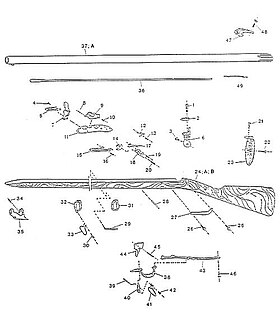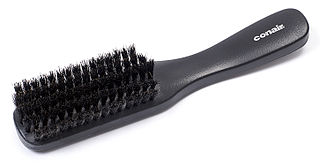
A ruler, sometimes called a rule or line gauge, is a device used in geometry and technical drawing, as well as the engineering and construction industries, to measure distances or draw straight lines.

The Charleville musket was a .69 caliber standard French infantry musket used in the 18th and 19th centuries. It was made in 1717 and was last produced during the 1840s. However, it still saw limited use in conflicts through the mid-19th century.

The Rogallo wing is a flexible type of wing. In 1948, Francis Rogallo, a NASA engineer, and his wife Gertrude Rogallo, invented a self-inflating flexible wing they called the Parawing, also known after them as the "Rogallo Wing" and flexible wing. NASA considered Rogallo's flexible wing as an alternative recovery system for the Mercury and Gemini space capsules, and for possible use in other spacecraft landings, but the idea was dropped from Gemini in 1964 in favor of conventional parachutes.

A tape measure or measuring tape is a flexible ruler used to measure size or distance.
Kite types, kite mooring, and kite applications result in a wide variety of kite control systems. Contemporary manufacturers, kite athletes, kite pilots, scientists, and engineers are expanding the possibilities.

A hairbrush is a handle brush with rigid or soft spokes used in hair care for smoothing, styling, and detangling human hair, or for grooming an animal's fur. It can also be used for styling in combination with a curling iron or hair dryer.

DECtape, originally called Microtape, is a magnetic tape data storage medium used with many Digital Equipment Corporation computers, including the PDP-6, PDP-8, LINC-8, PDP-9, PDP-10, PDP-11, PDP-12, and the PDP-15. On DEC's 32-bit systems, VAX/VMS support for it was implemented but did not become an official part of the product lineup.

Quarter inch cartridge tape is a magnetic tape data storage format introduced by 3M in 1972, with derivatives still in use as of 2016. QIC comes in a rugged enclosed package of aluminum and plastic that holds two tape reels driven by a single belt in direct contact with the tape. The tape was originally 1⁄4 inch (6.35 mm) wide and anywhere from 300 to 1,500 feet long. Data is written linearly along the length of the tape in one track, or written "serpentine", one track at a time, the drive reversing direction at the end of the tape, and each track's data written in the opposite direction to its neighbor. Since its introduction, it has been widely used, and many variations exist. There is a QIC trade association that publishes QIC standards which include interfaces and logical formats. To a very large extent it was the efficiency and openness of this organization which encouraged hardware and software developers to use this type of drive and media.

The kicksled or spark is a small sled consisting of a chair mounted on a pair of flexible metal runners that extend backward to about twice the chair's length. The sled is propelled by kicking the ground by foot. There is a handlebar attached to the top of the chair back. "Kicksled" is a direct translation of the Finnish word "potkukelkka". Some other possible translations are "kicker" and "chair-sled".

Peter Lynn is a New Zealand kitemaker, engineer and inventor. He is notable for his construction of the world's largest kites, giant inflatable (sparless) display kites, the popularisation of kite buggying and contributions to the development of power kiting and kitesurfing. He spends much of the year travelling worldwide and displaying his kites at International Kite Festivals.
The sled kite was invented and patented by the American, William Allison in the 1950s. This kite helped pave the way for a class of kites known as "semi-rigid."

The ram-air inflatable single-line kite is one of the few modern inventions in the world of kite design. Although Francis Rogallo's early kite patents had ram-air members in the claims, Domina Jalbert's parafoil ram-air wing, patented in 1944, emphatically changed the kite airscape for inflatable kites.

Fighter kites are kites used for the sport of kite fighting. Traditionally most are small, unstable single-line flat kites where line tension alone is used for control, at least part of which is manja, typically glass-coated cotton strands, to cut down the line of others.
Domina Cleophas Jalbert (1904–1991) invented the ram-air inflated flexible wing often called the "Jalbert parafoil".

Kites are tethered flying objects which fly by using aerodynamic lift, requiring wind for generation of airflow over the lifting surfaces.

The SZD-48 Jantar Standard 2 is a Standard Class glider that was designed and produced in Poland starting in 1977.

A fashion boot is a boot worn for reasons of style or fashion. The term is usually applied to women's boots. Fashion boots come in a wide variety of styles, from ankle to thigh-length, and are used for casual, formal, and business attire. Although boots were a popular style of women's footwear in the Nineteenth Century, they were not recognized as a high fashion item until the 1960s. They became widely popular in the 1970s and have remained a staple of women's winter wardrobes since then.

The United States provided many inventions in the time from the Colonial Period to the Gilded Age, which were achieved by inventors who were either native-born or naturalized citizens of the United States. Copyright protection secures a person's right to his or her first-to-invent claim of the original invention in question, highlighted in Article I, Section 8, Clause 8 of the United States Constitution, which gives the following enumerated power to the United States Congress:
To promote the Progress of Science and useful Arts, by securing for limited Times to Authors and Inventors the exclusive Right to their respective Writings and Discoveries.

Flexible Flyer is a toy and recreational equipment brand, best known for the sled of the same name, a steerable wooden sled with steel runners.
Diamond Reef System, including each individual Hover Station and the new Multi-Portal System, are trademarked, skill evaluation and safety-based diving curriculums that utilize the world's first portable, collapsible underwater obstacle course to simulate fragile reef or dive wreck structure for diver buoyancy skill and underwater photography training. A form of scuba Gymkhana, the program was designed by Pete Wallingford in 1988 to educate scuba instructors and scuba divers on how to safely teach and promote situational awareness, proper body positioning and safe interaction with coral reefs, fragile marine ecosystems and shipwrecks. The program was adopted by the Environmental Protection Agency, the National Oceanic and Atmospheric Administration, dive store operators and dive resort/charter operators worldwide.


















